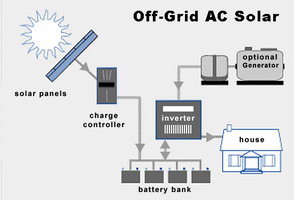Micro combined heat and power technology known as micro CHP or micro Cogen, is on the brink of changing how Canadians power and heat their businesses and homes. Micro CHP technology is based on the same concept as cogeneration, where both heat and electricity are generated using a single fuel. Egenolf micro CHP systems are designed for stand-alone (off-grid) applications, using wet or dry conventional fuels like Diesel, LPG or NG as well as renewable energy fuels such as VO, WVO, Biodiesel, Woodgas and Biogas.

A typical off-grid power system contains a battery bank, a battery based inverter, Photovoltaik and a back-up generator. During the fall and winter month with short days the generator is supplementing the system with electricity needed to charge up the batteries.
The weak point in such a hybrid system is the inefficiency of the power generator. Electricity produced by a conventional (diesel, gas or propane) generator is only utilizing 30-40% of the input fuels energy content. The balance 60-70% of the energy content is ending up as unused waste heat. During the times of the year, when you have to run the generator, its usually heating season as well. So why not utilizing the waste heat, store it and heat your house, shop or camp and saving on your heating fuel (wood, oil, propane)
During and in addition to my work for the NRC's IRAP Program in the last two years, I have developed a stand alone Micro Combined Heat & Power system, which is controlled by either the demand for power or for heat, whichever comes first. By doing so, the total efficiency increases to between 85% to 90% depending on fuel type and generator used, compared to 30% to 40% for conventional generators.
How microCHP technology works :
The thermal energy of the coolant from the liquid cooled generator engine as well as of the exhaust gas are captured with special designed hydronic heat exchangers and stored into a large buffer tank (Thermal Battery). Thermostatically controlled heat loads withdraw the stored heat from the buffer tank on demand. If the stored heat in the buffer tank reaches its lower threshold the generator automatically starts up (Heat Mode), charging up the buffer tank with heat.
At the same time while the generator is running the battery bank gets charged up and an automatic transfer switch supplies power to the connected electrical loads.
In case the the demand for charging up the batteries comes first (Power Mode) all the waste heat from running the generator is stored in the buffer tank for future heat demand. The buffer tank is designed to store enough heat for a typical generator running cycle, without having to direct surplus heat into a dump load in order to avoid overheating of the system. Extremely efficient insulation keeps the heat loss in the buffer tank to a minimum.
If the electrical load on the generator is below 40%, electrical heaters build into the buffer tank increase the electrical load on the generator to the most efficient threshold for the specific generator type. That is especially important for diesel gensets, since they trnd to 'Wet-Staking' when under performed.
What kind of generators and fuel types are preferred :
Any liquid cooled Diesel, LPG (Propane) or Natural Gas generators can be converted into a mCHP system.
Alternative fuel types like Biodiesel, Veggie Oil, Hydrogen enhanced fuels and Wood Gas can be used with engine and control modifications.
How much energy output can be produced :
For example a 15kW diesel generator produces about 25kW/h (85,300Btu/hr) in heat at full continuous load.
A typical running cycle takes somewhere between 4-5hrs. The thermal heat produced and stored during the running cycle is between 341,000 and 426,000Btu's in addition to the 60-75kWh on electricity produced at the same time. In reality you wont run your generator at a 100% load for a full running cycle and load fluctuations in a stand alone operation are very normal. Therefore the realistic values vary between 60 to 90% of the above mentioned full load values depending on your specific situation.
